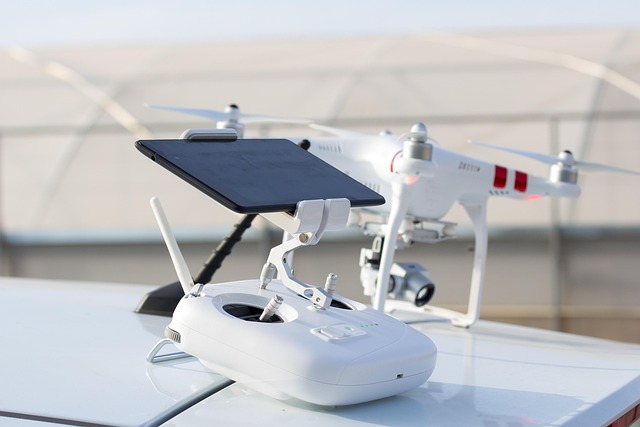Drone surveillance technology has revolutionized aerial security by providing advanced, real-time monitoring solutions. Equipped with high-resolution cameras, sensors, and AI, drones navigate hard-to-reach areas, capture detailed imagery, and offer automated threat recognition. Real-time data transmission enhances response times, making these aerial security solutions highly effective for diverse applications like border security, event management, and environmental monitoring. Despite legal and ethical considerations, the integration of drones into surveillance systems significantly improves situational awareness and operational efficiency while sparking important discussions on privacy and freedom.
In an era driven by real-time data, advanced drone surveillance emerges as a revolutionary force in enhancing security monitoring. This article explores the transformative power of drone technology in providing aerial security solutions. From the evolution of sophisticated drone capabilities to the legal and ethical considerations surrounding their deployment, we delve into the intricate details. We also examine the cutting-edge sensors and camera systems that equip drones with unparalleled situational awareness, enabling seamless integration with existing security infrastructure. Discover how these innovative aerial security solutions are redefining protection in today’s dynamic landscape.
The Evolution of Drone Surveillance Technology
The evolution of drone surveillance technology has revolutionized aerial security solutions, offering unprecedented capabilities for real-time monitoring. What once required large, fixed-wing aircraft and ground teams is now achievable with smaller, more agile drones that can swiftly navigate hard-to-reach areas. These advanced drones are equipped with high-resolution cameras, thermal imaging sensors, and powerful data processing units, enabling them to capture detailed imagery and critical information from the sky.
The integration of artificial intelligence (AI) has further enhanced drone surveillance, allowing for automated target recognition, behavior analysis, and predictive analytics. This not only improves efficiency but also ensures that security personnel can focus on complex decision-making tasks. With real-time data transmission capabilities, operators can quickly respond to emerging threats, making aerial security solutions more dynamic and effective than ever before.
– Exploring the advancements in drone capabilities for security monitoring.
The realm of advanced drone surveillance is revolutionizing real-time security monitoring, offering unprecedented capabilities in the world of aerial security solutions. These innovative aerial vehicles are equipped with cutting-edge sensors, cameras, and data processing systems, enabling them to provide comprehensive and dynamic coverage for various security applications. With their ability to access hard-to-reach areas and cover vast landscapes, drones provide a cost-effective and efficient alternative to traditional security methods.
Advanced drone technology now allows for high-definition imaging, thermal sensing, and real-time data transmission, ensuring that security personnel have access to critical information whenever needed. These aerial security solutions can be tailored to specific requirements, whether it’s monitoring remote infrastructure, enhancing border security, or supporting emergency response teams. By leveraging the potential of drones, organizations can streamline their security protocols, improve response times, and achieve a new level of situational awareness.
Real-Time Security Monitoring with Drones
Real-time security monitoring has entered a new era with the integration of advanced drone surveillance. Drones, equipped with high-resolution cameras and sophisticated sensors, offer an unparalleled level of aerial security solutions. They can swiftly scan vast areas, providing live feeds that give security personnel crucial insights into potential threats or unusual activities.
This technology enables continuous monitoring, especially in challenging-to-reach locations, offering a dynamic and responsive approach to security. With their agility and ability to capture detailed imagery, drones enhance situational awareness, allowing for swift decision-making and efficient resource allocation. Real-time data transmission ensures that security teams can promptly address any incidents, enhancing overall operational effectiveness.
– Understanding the benefits and applications of aerial surveillance in providing instant alerts and data.
Aerial surveillance using drones offers a revolutionary approach to real-time security monitoring, providing instant alerts and valuable data that traditional methods struggle to match. Drones equipped with advanced cameras and sensors can capture high-resolution imagery and gather intel from hard-to-reach or expansive areas in a fraction of the time it would take ground teams. This capability is particularly beneficial for large-scale events, border patrols, and environmental monitoring, where quick response times are crucial.
By leveraging aerial security solutions, organizations can enhance their situational awareness, detect potential threats promptly, and make informed decisions rapidly. Instant alerts about suspicious activities or unauthorized access trigger immediate responses, minimizing the time window for malicious actions to escalate. Moreover, drones can collect and transmit data in real-time, including video feeds, heatmaps, and location tags, which are invaluable for incident management and post-event analysis.
Drone Deployment: Legal and Ethical Considerations
The integration of drones into surveillance systems offers unprecedented capabilities for real-time security monitoring, providing advanced aerial security solutions. However, their deployment raises important legal and ethical considerations. Regulatory bodies worldwide are establishing guidelines to ensure safe and responsible drone use, addressing privacy concerns and maintaining public safety. These regulations vary across jurisdictions, demanding operators to obtain licenses, follow specific flight paths, and respect no-fly zones, especially in areas with sensitive infrastructure or crowded spaces.
Ethical debates also surround drone surveillance, particularly regarding the potential for misuse, data protection, and civil liberties. The collection and storage of aerial footage raise questions about privacy rights, especially when drones are used in public spaces. Striking a balance between enhancing security through advanced aerial security solutions and preserving individual freedoms is an ongoing challenge that requires continuous dialogue between technology developers, policymakers, and the public.
Advanced drone surveillance technology offers a revolutionary approach to real-time security monitoring, transforming the way we protect our spaces. By leveraging these aerial security solutions, organizations can gain unprecedented insights into their environments, enabling swift response to potential threats. As this technology continues to evolve, it’s crucial to balance its benefits with legal and ethical considerations, ensuring a safe and responsible implementation of drone surveillance for a secure future.
